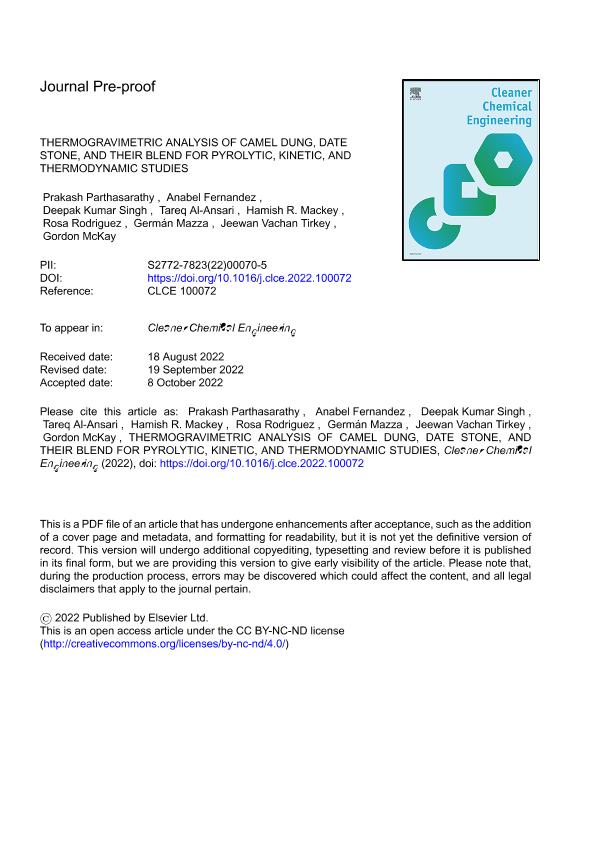Mostrar el registro sencillo del ítem
dc.contributor.author
Parthasarathy, Prakash
dc.contributor.author
Fernandez Brizuela, Anabel Alejandra

dc.contributor.author
Kumar Singh, Deepak
dc.contributor.author
Al Ansari, Tareq
dc.contributor.author
Mackey, Hamish R.
dc.contributor.author
Rodriguez, Rosa Ana

dc.contributor.author
Mazza, German Delfor

dc.contributor.author
Vachan Tirkey, Jeewan
dc.contributor.author
McKay, Gordon
dc.date.available
2023-11-13T12:37:57Z
dc.date.issued
2022-10
dc.identifier.citation
Parthasarathy, Prakash; Fernandez Brizuela, Anabel Alejandra; Kumar Singh, Deepak; Al Ansari, Tareq; Mackey, Hamish R.; et al.; Thermogravimetric analysis of camel dung, date stone, and their blend for pyrolytic kinetic, and thermodynamic studies; Elsevier; Cleaner Chemical Engineering; 4; 10-2022; 1-10
dc.identifier.issn
2772-7823
dc.identifier.uri
http://hdl.handle.net/11336/217854
dc.description.abstract
Cameldung (CM) and date stone (DS) are biomass resources that are abundant acrossthe Gulf region and have the potential to produce sustainable renewable fuelsand specialty products. Copyrolysis of camel dung with DS is an intriguingresearch approach to boosting both the production and quality of pyrolysisproducts, particularly biochar. The current study investigated the bio-energypotential of CM, DS, and CD-DS blend by assessing their physicochemical attributes,pyrolysis characteristics, and kinetic behaviour using thermodynamic analysis.To investigate the pyrolysis behaviour, the materials were thermally decomposedusing a thermogravimetric analyser under non-isothermal conditions at differentheating rates in a nitrogen environment. The findings of the physicochemicalanalysis established the bio-energy potential of the feedstocks for long-termenergy generation. Thermal degradation profiles of the samples revealedmultistage degradation due to the various components in their structure. Whilea positive synergistic effect between DS and CD was observed in the thermalprofile of the blend. The average apparent activation energy of CD from theFriedman method, Flynn-Wall-Ozawa (FWO) model, Kissinger-Akahira-Sunose (KAS)method, and Starink model was 324, 167, 157, and 158 kJ/mol, respectively.Friedman, FWO, KAS, and Starink methods yielded average activation energies of621, 315, 276, and 279 kJ/mol for DS, respectively. The mean activation energyof the blend estimated using the Friedman, FWO, KAS, and Starink methods was210, 216, 206, and 207 kJ/mol, respectively. The thermodynamic outcomes revealthat slow pyrolysis of the specified feedstocks is a nonspontaneous processrequiring external energy for their degradation. The findings of this study mayaid in a better understanding of reaction processes and the expansion of pyrolysisapplications of DS, CD, and their mix.
dc.format
application/pdf
dc.language.iso
eng
dc.publisher
Elsevier

dc.rights
info:eu-repo/semantics/openAccess
dc.rights.uri
https://creativecommons.org/licenses/by-nc-nd/2.5/ar/
dc.subject
CAMEL DUNG
dc.subject
DATE STONE
dc.subject
PYROLYSIS
dc.subject
THERMOGRAVIMETRIC ANALYSIS
dc.subject
KINETIC ANALYSIS
dc.subject
THERMODYNAMIC PROPERTIES
dc.subject.classification
Ingeniería de Procesos Químicos

dc.subject.classification
Ingeniería Química

dc.subject.classification
INGENIERÍAS Y TECNOLOGÍAS

dc.title
Thermogravimetric analysis of camel dung, date stone, and their blend for pyrolytic kinetic, and thermodynamic studies
dc.type
info:eu-repo/semantics/article
dc.type
info:ar-repo/semantics/artículo
dc.type
info:eu-repo/semantics/publishedVersion
dc.date.updated
2023-11-10T14:33:14Z
dc.journal.volume
4
dc.journal.pagination
1-10
dc.journal.pais
Países Bajos

dc.journal.ciudad
Amsterdam
dc.description.fil
Fil: Parthasarathy, Prakash. Hamad Bin Khalifa University; Qatar
dc.description.fil
Fil: Fernandez Brizuela, Anabel Alejandra. Consejo Nacional de Investigaciones Cientificas y Tecnicas. Centro Cientifico Tecnologico Conicet - Patagonia Confluencia. Instituto de Investigacion y Desarrollo En Ingenieria de Procesos, Biotecnologia y Energias Alternativas. Grupo Vinculado Instituto de Ingenieria Quimica | Universidad Nacional del Comahue. Instituto de Investigacion y Desarrollo En Ingenieria de Procesos, Biotecnologia y Energias Alternativas. Grupo Vinculado Instituto de Ingenieria Quimica.; Argentina
dc.description.fil
Fil: Kumar Singh, Deepak. Indian Institute of Technology; India
dc.description.fil
Fil: Al Ansari, Tareq. Hamad Bin Khalifa University; Qatar
dc.description.fil
Fil: Mackey, Hamish R.. Hamad Bin Khalifa University; Qatar
dc.description.fil
Fil: Rodriguez, Rosa Ana. Consejo Nacional de Investigaciones Cientificas y Tecnicas. Centro Cientifico Tecnologico Conicet - Patagonia Confluencia. Instituto de Investigacion y Desarrollo En Ingenieria de Procesos, Biotecnologia y Energias Alternativas. Grupo Vinculado Instituto de Ingenieria Quimica | Universidad Nacional del Comahue. Instituto de Investigacion y Desarrollo En Ingenieria de Procesos, Biotecnologia y Energias Alternativas. Grupo Vinculado Instituto de Ingenieria Quimica.; Argentina
dc.description.fil
Fil: Mazza, German Delfor. Consejo Nacional de Investigaciones Científicas y Técnicas. Centro Científico Tecnológico Conicet - Patagonia Norte. Instituto de Investigación y Desarrollo en Ingeniería de Procesos, Biotecnología y Energías Alternativas. Universidad Nacional del Comahue. Instituto de Investigación y Desarrollo en Ingeniería de Procesos, Biotecnología y Energías Alternativas; Argentina
dc.description.fil
Fil: Vachan Tirkey, Jeewan. Indian Institute Of Technology. Mechanical & Industrial Engineering Departament; India
dc.description.fil
Fil: McKay, Gordon. Hamad Bin Khalifa University; Qatar
dc.journal.title
Cleaner Chemical Engineering
dc.relation.alternativeid
info:eu-repo/semantics/altIdentifier/url/https://www.sciencedirect.com/journal/cleaner-chemical-engineering
dc.relation.alternativeid
info:eu-repo/semantics/altIdentifier/doi/https://doi.org/10.1016/j.clce.2022.100072
Archivos asociados
